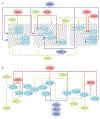Light Perception: A Matter of Time
- PMID: 32068156
- PMCID: PMC7056494
- DOI: 10.1016/j.molp.2020.02.006
Light Perception: A Matter of Time
Abstract
Optimizing the perception of external cues and regulating physiology accordingly help plants to cope with the constantly changing environmental conditions to which they are exposed. An array of photoreceptors and intricate signaling pathways allow plants to convey the surrounding light information and synchronize an endogenous timekeeping system known as the circadian clock. This biological clock integrates multiple cues to modulate a myriad of downstream responses, timing them to occur at the best moment of the day and the year. Notably, the mechanism underlying entrainment of the light-mediated clock is not clear. This review addresses known interactions between the light-signaling and circadian-clock networks, focusing on the role of light in clock entrainment and known molecular players in this process.
Keywords: Arabidopsis thaliana; circadian clock; light entrainment; light signaling; photoreceptors; signal integration.
Copyright © 2020 The Author. Published by Elsevier Inc. All rights reserved.
Figures



References
-
- Ahmad M (2016). Photocycle and signaling mechanisms of plant cryptochromes. Curr Opin Plant Biol. 33:108–115. - PubMed
-
- Ahmad M, Jarillo JA, Smirnova O, and Cashmore AA (1998). The CRY1 Blue Light Photoreceptor of Arabidopsis Interacts with Phytochrome A In Vitro. Molecular Cell 1:939–948. - PubMed
-
- Alabadí D, Oyama T, Yanovsky MJ, Harmon FG, Mas P, and Kay SA (2001). Reciprocal regulation between TOC1 and LHY/CCA1 within the Arabidopsis circadian clock. Science 293:880–883. - PubMed
Publication types
MeSH terms
Grants and funding
LinkOut - more resources
Full Text Sources

